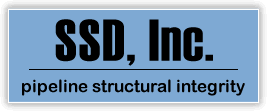

The All American oil transmission pipeline crosses the San Andreas fault zone southwest of Bakersfield, California. The possibility of fault rupture in the fault zone during a major earthquake is a source of concern, since this could result in pipeline damage or failure. All American Pipe Line (AAPL) Company commissioned SSD to develop a site-specific fault displacement risk model to evaluate the risk levels, and to review various design alternatives. At the completion of the project, a practical design scheme, which significantly reduced the risk of pipeline damage or failure was recommended and implemented.
The first phase of the project involved the development of a fault displacement risk model at the location where the pipeline crosses the San Andreas fault. The model developed was a Gutenberg-Richter based procedure that accounted for: (a) magnitude vs. return period data for the San Andreas fault; (b) statistical magnitude vs. maximum fault offset relationships; (c) magnitude vs. probability of surface rupture; and (d) magnitude and rupture lengths vs. probability of surface rupture at AAPL site. The end result from the risk model was a series of curves which provided a relationship between the probability of exceedence and a given level of fault offset displacement.
The next phase of the project concerned the development and analysis of a series of pipeline fault displacement models of the fault zone, using the PIPLIN program. These analyses provided estimates of pipeline performance (specifically the fault offset required to induce damage or failure) under various fault movement scenarios. The first step was to develop appropriate strain based damage and failure criteria for the pipeline. The next step included developing models of the initial fault crossing design and various alternate designs, and analysis of these models subject to fault motion until the damage and failure strain limits were reached or exceeded.
Comparisons of the fault offset required to cause pipeline damage or failure for various fault crossing designs provide a reasonable means of ranking design alternates. However, combining the results from the fault crossing analyses with the results from the fault displacement risk model offers a more rational decision making basis than the offset capacity alone. The risks associated with a given fault crossing design were estimated in terms of the probability that the fault offsets required to cause pipeline damage or failure would be exceeded over the design life of the pipeline.
The end result of this work was the recommendation and implementation of a scheme, that involved exposing the pipe for several hundred feet on either side of the main fault trace using a shallow-angled trench wall and backfilling with a loose, cohesionless gravel material. The loose cohesionless material provides a minimum of soil restraint on the pipeline. The shallow trench walls provide a ramp allowing the pipeline to easily "blow out" of the trench in the event of large fault movement. When compared to the initial design, this scheme increased the ultimate offset capacity at the fault by a factor of approximately four.
Home | Consulting Services | Project Profiles | Key Personnel | Contact Us
SSD, Inc. · 10643 Professional Circle, Suite A · Reno, NV 89521 · Phone (775)-770-1126 · Fax (775)-770-1129 · info@ssdinc.com